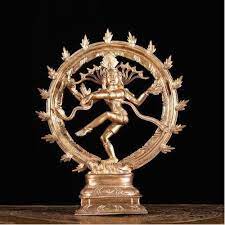29 Sep Nataraj

- Recently, as many as 157 artefacts and antiquitieswere handed over to the Prime Minister by the United States including a bronze Nataraj figure.
- The list has a diverse set of items bas-relief panel of Revantain sandstone made in the 10th century, 56 terracotta pieces, several bronze figurines and copper objects, among others which mainly belong to 11th and 14th
- It also includes an18th century sword in its sheath, with the inscription mentioning Guru Hargovind singh in Persian, some historic antiquities comprise figurines relating to Hinduism, Buddhism and Jainism
Important Points
- Nataraja (Lord of the Dance), the Hindu god Shivain his form as the cosmic dancer, is represented in metal or stone in many Shaivite temples, particularly in South India.
- It is an important piece of Chola sculpture.
- The upper right-handholds the drum, which signifies the sound of creation. All creations spring from the great sound of the damru.
- The upper left-handholds the eternal fire, which represents the destruction. Destruction is the precursor and inevitable counterpart of creation.
- The lower right handis raised in the gesture of Abhay mudra signifying benediction and reassuring the devotee to not be afraid.
- The lower left-handpoints towards the upraised foot and indicates the path of salvation.
- Shiva is dancing on the figure of a small dwarf. The dwarf symbolises ignoranceand the ego of an individual.
- Shiva is shown as the source of all movement within the cosmosand as the god whose doomsday dance, represented by the arch of flames, accompanies the dissolution of the universe at the end of an eon.
- The matted and flowing locks of Shiva represent the flow of river Ganges.
- In ornamentation, one ear of Shiva has a male earring while the other has a female. This represents the fusion of male and female and is often referred to as Ardhanarishwar.
- A snake is twisted around the arm of Shiva. The snake symbolises the kundalini power, which resides in the human spine in the dormant stage. If aroused, one can attain true consciousness.
- The Nataraja is surrounded by a nimbus of glowing lights which symbolises the vast unending cycles of time.


No Comments